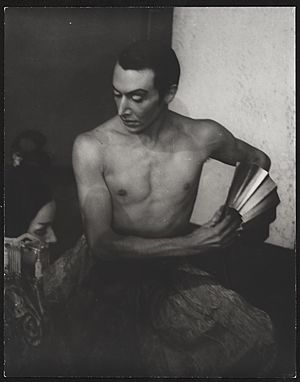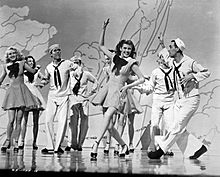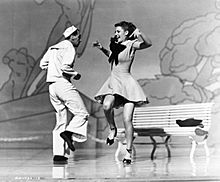Jack Cole (choreographer) facts for kids
Quick facts for kids
Jack Cole
|
|
|---|---|
 |
|
| Born |
John Ewing Richter
April 27, 1911 |
| Died | February 17, 1974 (aged 62) Los Angeles, California, U.S.
|
| Occupation |
|
Jack Cole (born April 27, 1911 – died February 17, 1974) was an American dancer and choreographer. He was also a theatre director. Many people called him "the Father of Theatrical Jazz Dance" because of his important work.
Contents
Early Life and Dance Beginnings
Jack Cole first performed as a professional dancer in August 1930. This was at Lewisohn Stadium in New York City. He had only started learning modern dance six weeks before. His teachers were Ruth St. Denis and Ted Shawn. He loved how their dance school used Asian styles in its dances and costumes.
He also danced for a short time with Humphrey-Weidman. He learned from the famous modern dancers Doris Humphrey and Charles Weidman. During the Great Depression, he wanted to make a living dancing. So, he left the modern dance world. He found chances to dance in nightclubs instead. He first danced with Alice Dudley. Then, for many years, he danced in a group of three with Anna Austin and Florence Lessing.
Cole's dance career was special for an American artist. He started with modern dance. Then, he became very successful in nightclubs across the country. He first danced at Manhattan's Embassy Club. He also opened the Rainbow Room on its first night in October 1934. His career covered three main areas: nightclubs, Broadway stages, and Hollywood movies. He finished his career as a popular coach for Hollywood stars. He also created new dances for movies.
Career Highlights
Cole performed in Broadway musicals. His first was The Dream of Sganarelle in 1933. His first job as a choreographer on Broadway was for Something for the Boys in 1943. Cole helped create dances or directed many stage musicals. Some of these include Kismet, A Funny Thing Happened on the Way to the Forum, and Man of La Mancha.
The Jack Cole Dancers performed in nightclubs in the late 1930s. One famous place was the Rainbow Room.
Mixing Dance Styles
Cole was a leader in bringing different cultures into musical comedy dance. He learned from Ruth St. Denis. But he felt her use of Eastern dance was not deep enough. He wanted to use more real parts of cultural dances in his work. So, he studied many traditional dance forms from other countries.
Cole became very good at bharata nāṭyam. This is India’s oldest dance style. He learned it from dancers Uday Shankar and La Meri. In the 1930s, he also became interested in Latin American and Caribbean dances. He studied Flamenco with Paco Cansino. Paco was the uncle of film star Rita Hayworth.
Cole combined these techniques with popular social dances from the 1920s and 30s. These included the Charleston and the Lindy. He said these dances "all came from African dance" and the Caribbean. Acrobatic knee slides were another special move of Cole's. These likely came from The Nicholas Brothers' tap dance acts.
In the late 1940s, many Cubans moved to New York. They brought the mambo, rumba, and cha-cha-cha dances. Cole also used these dance styles in his work.
Some people wondered about Cole's focus on dances from other cultures and religions. Dance historian Constance Valis Hill said he either "absorbed, borrowed, or appropriated" these elements. But she also said Cole respected the beauty of these cultural dances. He wove them into his work without changing their original shapes or rhythms.
One great example of Jack Cole mixing bharata nāṭyam with jazz music was his "Hindu Swing" work. One expert on Indian dance said Cole performed "authentic Indian dance technique to swing tempos." He did this "without losing the general dignity of the art."
Hollywood Work
Jack Cole was very famous in Hollywood. He worked with stars like Rita Hayworth, Betty Grable, Jane Russell, Mitzi Gaynor, and Marilyn Monroe. Cole worked closely with Marilyn Monroe. He helped her create her famous performance in "Diamonds are a Girl's Best Friend." This was from the movie Gentlemen Prefer Blondes. He worked with her on five other films too.
Howard Hawks is listed as the only director for Gentlemen Prefer Blondes. But Jane Russell, who co-starred, and Gwen Verdon, an assistant choreographer, said Cole actually directed Monroe's "Diamonds Are a Girl's Best Friend" number. Russell said, "Howard Hawks had nothing to do with the musical numbers. He was not even there."
Legacy and Influence
Jack Cole basically created the style of American show dancing known as "theatrical jazz dance." He developed a mix of jazz-ethnic-ballet. This style is still the main way of dancing in today's musicals, films, nightclub shows, television commercials, and music videos. Martin Gottfried, a writer, said Cole "won a place in choreographic history." He did this by creating the basic moves of jazz dancing. This is the kind of dancing seen in nightclubs and Broadway musicals.
Cole's dance style is energetic and sharp. It often uses small groups of dancers instead of large ones. It looks more like a dazzling nightclub show than a ballet stage.
Cole is remembered as the main inventor of theatrical jazz dance.
Cole's unique style lives on in the work of many dancers and choreographers. These include Gwen Verdon, Bob Fosse, Jerome Robbins, Gower Champion, Peter Gennaro, Michael Bennett, Tommy Tune, Patsy Swayze, Alvin Ailey, and Wayne Lamb. Gwen Verdon said that "Jack influenced all the choreographers in the theater." She named Jerome Robbins, Michael Kidd, Bob Fosse, Michael Bennett, and Ron Field. She added, "When you see dancing on television, that's Jack Cole." Verdon worked as Cole's assistant for seven years.
If not for Cole, Gwen Verdon might not have become a famous dancer. Many famous stage and screen actresses might not be remembered as dancers today without his teaching.
Madonna used Cole's choreography from the "Diamonds are a Girl's Best Friend" scene in Gentlemen Prefer Blondes. She reinterpreted it for her music video "Material Girl."
Some early critics thought Cole’s nightclub work was too commercial and not "real art." But by bringing his style to Broadway and Hollywood, he showed they were wrong. He gave more respect to commercial dance. Even so, he is not as well-known as some dancers he inspired, like Bob Fosse and Jerome Robbins.
After the Denishawn Dance group broke up, Cole kept working with Ted Shawn. He was part of a small group of dancers who helped Shawn start Jacob’s Pillow. This is a famous summer dance center. Many years later, Chet Walker, a teacher at Jacob’s Pillow, created a musical to honor Jack Cole. It was called Heat Wave: The Jack Cole Project. It first showed in May 2012 in New York.
See also
- List of dancers




